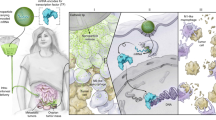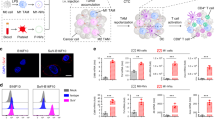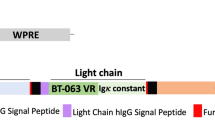Abstract
The objective of this study is to genetically engineer macrophages (Mφ) for biological activation and evaluate their anti-tumor activity in a tumor-bearing mouse model. Mouse peritoneal Mφ were incubated on the surface of a culture dish which had been coated with the complex of a cationized dextran and luciferase plasmid DNA complex plus a cell adhesion protein, Pronectin for gene transfection (reverse transfection). When compared with the conventional transfection where Mφ were transfected in the medium containing the complex, the level of gene expression by the reverse method was significantly high and the time period of gene expression was prolonged. Confocal microscopic observation revealed that the plasmid DNA was localized in the cell nucleus to a higher extent by the reverse transfection method. Following the reverse transfection of Mφ by the plasmid DNA of a hepatocyte growth factor antagonist (NK4) complexed with the cationized dextran, the NK4 protein was secreted at a higher amount for a longer time period in contrast to the conventional transfection of free plasmid DNA. The NK4-transfected Mφ exhibited a stronger inhibition activity for in vitro growth of Meth-A fibrosarcoma cells. When injected intravenously into mice carrying a mass of Meth-A tumor cells, the Mφ engineered were accumulated in the tumor tissue and showed significant anti-tumor activity. It is concluded that the Mφ injected functioned as the natural carrier of tumor targeting for anti-tumor NK4 molecules, resulting in enhanced suppression of tumor growth at a high selectivity.
This is a preview of subscription content, access via your institution
Access options
Subscribe to this journal
Receive 12 print issues and online access
$259.00 per year
only $21.58 per issue
Buy this article
- Purchase on Springer Link
- Instant access to full article PDF
Prices may be subject to local taxes which are calculated during checkout







Similar content being viewed by others
References
Tabata Y, Ikada Y . Drug delivery systems for antitumor activation of macrophages. Crit Rev Ther Drug Carrier Syst 1990; 7: 121–148.
Gafni Y, Turgeman G, Liebergal M, Pelled G, Gazit Z, Gazit D . Stem cells as vehicles for orthopedic gene therapy. Gene Therapy 2004; 11: 417–426.
Chang SC, Chuang HL, Chen YR, Chen JK, Chung HY, Lu YL et al. Ex vivo gene therapy in autologous bone marrow stromal stem cells for tissue-engineered maxillofacial bone regeneration. Gene Therapy 2003; 10: 2013–2019.
Cho KC, Kim SH, Jeong JH, Park TG . Folate receptor-mediated gene delivery using folate-poly(ethylene glycol)-poly(L-lysine) conjugate. Macromol Biosci 2005; 5: 512–519.
Turgeman G, Pittman DD, Muller R, Kurkalli BG, Zhou S, Pelled G et al. Engineered human mesenchymal stem cells: a novel platform for skeletal cell mediated gene therapy. J Gene Med 2001; 3: 240–251.
Mangi AA, Noiseux N, Kong D, He H, Rezvani M, Ingwall JS et al. Mesenchymal stem cells modified with Akt prevent remodeling and restore performance of infarcted hearts. Nat Med 2003; 9: 1195–1201.
Sato H, Kuwashima N, Sakaida T, Hatano M, Dusak JE, Fellows-Mayle WK et al. Epidermal growth factor receptor-transfected bone marrow stromal cells exhibit enhanced migratory response and therapeutic potential against murine brain tumors. Cancer Gene Ther 2005; 12: 757–768.
Studeny M, Marini FC, Dembinski JL, Zompetta C, Cabreira-Hansen M, Bekele BN et al. Mesenchymal stem cells: potential precursors for tumor stroma and targeted-delivery vehicles for anticancer agents. J Natl Cancer Inst 2004; 96: 1593–1603.
De Smedt SC, Demeester J, Hennink WE . Cationic polymer based gene delivery systems. Pharm Res 2000; 17: 113–126.
Ewert K, Slack NL, Ahmad A, Evans HM, Lin AJ, Samuel CE et al. Cationic lipid-DNA complexes for gene therapy: understanding the relationship between complex structure and gene delivery pathways at the molecular level. Curr Med Chem 2004; 11: 133–149.
Pedroso de Lima MC, Neves S, Filipe A, Duzgunes N, Simoes S . Cationic liposomes for gene delivery: from biophysics to biological applications. Curr Med Chem 2003; 10: 1221–1231.
Hirko A, Tang F, Hughes JA . Cationic lipid vectors for plasmid DNA delivery. Curr Med Chem 2003; 10: 1185–1193.
Okazaki A, Jo J, Tabata Y . A reverse transfection technology to genetically engineer adult stem cells. Tissue Eng 2007; 13: 245–251.
Nakamura T, Nishizawa T, Hagiya M, Seki T, Shimonishi M, Sugimura A et al. Molecular cloning and expression of human hepatocyte growth factor. Nature 1989; 342: 440–443.
Zarnegar R, Michalopoulos GK . The many faces of hepatocyte growth factor: from hepatopoiesis to hematopoiesis. J Cell Biol 1995; 129: 1177–1180.
Matsumoto K, Nakamura T . Hepatocyte growth factor (HGF) as a tissue organizer for organogenesis and regeneration. Biochem Biophys Res Commun 1997; 239: 639–644.
Birchmeier C, Gherardi E . Developmental roles of HGF/SF and its receptor, the c-Met tyrosine kinase. Trends Cell Biol 1998; 8: 404–410.
Cortner J, Vande Woude GF, Rong S . The Met-HGF/SF autocrine signaling mechanism is involved in sarcomagenesis. EXS 1995; 74: 89–121.
Rosen EM, Goldberg ID . Scatter factor and angiogenesis. Adv Cancer Res 1995; 67: 257–279.
Jeffers M, Rong S, Woude GF . Hepatocyte growth factor/scatter factor-Met signaling in tumorigenicity and invasion/metastasis. J Mol Med 1996; 74: 505–513.
To CT, Tsao MS . The roles of hepatocyte growth factor/scatter factor and met receptor in human cancers (Review). Oncol Rep 1998; 5: 1013–1024.
Jiang W, Hiscox S, Matsumoto K, Nakamura T . Hepatocyte growth factor/scatter factor, its molecular, cellular and clinical implications in cancer. Crit Rev Oncol Hematol 1999; 29: 209–248.
Date K, Matsumoto K, Shimura H, Tanaka M, Nakamura T . HGF/NK4 is a specific antagonist for pleiotrophic actions of hepatocyte growth factor. FEBS Lett 1997; 420: 1–6.
Date K, Matsumoto K, Kuba K, Shimura H, Tanaka M, Nakamura T . Inhibition of tumor growth and invasion by a four-kringle antagonist (HGF/NK4) for hepatocyte growth factor. Oncogene 1998; 17: 3045–3054.
Kuba K, Matsumoto K, Date K, Shimura H, Tanaka M, Nakamura T . HGF/NK4, a four-kringle antagonist of hepatocyte growth factor, is an angiogenesis inhibitor that suppresses tumor growth and metastasis in mice. Cancer Res 2000; 60: 6737–6743.
Tomioka D, Maehara N, Kuba K, Mizumoto K, Tanaka M, Matsumoto K et al. Inhibition of growth, invasion, and metastasis of human pancreatic carcinoma cells by NK4 in an orthotopic mouse model. Cancer Res 2001; 61: 7518–7524.
Saga Y, Mizukami H, Suzuki M, Urabe M, Kume A, Nakamura T et al. Expression of HGF/NK4 in ovarian cancer cells suppresses intraperitoneal dissemination and extends host survival. Gene Therapy 2001; 8: 1450–1455.
Maehara N, Nagai E, Mizumoto K, Sato N, Matsumoto K, Nakamura T et al. Gene transduction of NK4, HGF antagonist, inhibits in vitro invasion and in vivo growth of human pancreatic cancer. Clin Exp Metastasis 2002; 19: 417–426.
Hirao S, Yamada Y, Koyama F, Fujimoto H, Takahama Y, Ueno M et al. Tumor suppression effect using NK4, a molecule acting as an antagonist of HGF, on human gastric carcinomas. Cancer Gene Ther 2002; 9: 700–707.
Saimura M, Nagai E, Mizumoto K, Maehara N, Okino H, Katano M et al. Intraperitoneal injection of adenovirus-mediated NK4 gene suppresses peritoneal dissemination of pancreatic cancer cell line AsPC-1 in nude mice. Cancer Gene Ther 2002; 9: 799–806.
Maemondo M, Narumi K, Saijo Y, Usui K, Tahara M, Tazawa R et al. Targeting angiogenesis and HGF function using an adenoviral vector expressing the HGF antagonist NK4 for cancer therapy. Mol Ther 2002; 5: 177–185.
Park J, Ries J, Gelse K, Kloss F, von der Mark K, Wiltfang J et al. Bone regeneration in critical size defects by cell-mediated BMP-2 gene transfer: a comparison of adenoviral vectors and liposomes. Gene Therapy 2003; 10: 1089–1098.
Nagaya N, Kangawa K, Kanda M, Uematsu M, Horio T, Fukuyama N et al. Hybrid cell-gene therapy for pulmonary hypertension based on phagocytosing action of endothelial progenitor cells. Circulation 2003; 108: 889–895.
Jo J, Nagaya N, Miyahara Y, Kataoka M, Harada-Shiba M, Kangawa K et al. Transplantation of genetically engineered mesenchymal stem cells improves cardiac function in rats with myocardial infarction: benefit of a novel nonviral vector, cationized dextran. Tissue Eng 2007; 13: 313–322.
Herberman RB . Possible role of natural killer cells and other effector cells in immune surveillance against cancer. J Invest Dermatol 1984; 83: 137s–140s.
Hermanson GT . Bioconjugate Techniques. Academic Press: San Diego, CA, USA, 1996.
Tokui M, Takei I, Tashiro F, Shimada A, Kasuga A, Ishii M et al. Intramuscular injection of expression plasmid DNA is an effective means of long-term systemic delivery of interleukin-5. Biochem Biophys Res Commun 1997; 233: 527–531.
Ikada Y, Tabata Y . Phagocytosis of bioactive microspheres. J Bioact Compat Polym 1986; 1: 32–46.
Habeeb AF . Determination of free amino groups in proteins by trinitrobenzenesulfonic acid. Anal Biochem 1966; 14: 328–336.
Konishi M, Tabata Y, Kariya M, Hosseinkhani H, Suzuki A, Fukuhara K et al. In vivo anti-tumor effect of dual release of cisplatin and adriamycin from biodegradable gelatin hydrogel. J Control Release 2005; 103: 7–19.
Author information
Authors and Affiliations
Corresponding author
Rights and permissions
About this article
Cite this article
Okasora, T., Jo, Ji. & Tabata, Y. Augmented anti-tumor therapy through natural targetability of macrophages genetically engineered by NK4 plasmid DNA. Gene Ther 15, 524–530 (2008). https://doi.org/10.1038/gt.2008.5
Received:
Revised:
Accepted:
Published:
Issue Date:
DOI: https://doi.org/10.1038/gt.2008.5



